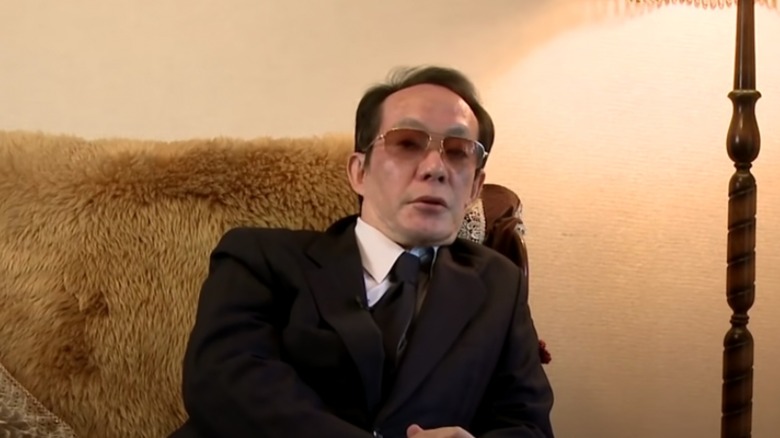Why Cannibal Issei Sagawa Was Never Convicted Of Murdering Renée Hartevelt
In the early morning hours of June 13, 1981, Japan native Issei Sagawa entered the Bois de Boulogne in Paris, France, with two large suitcases. As reported by New Criminologist, a couple, who described the man as "Asian-looking," saw him arrive at the park in a taxi cab and said seemed to be struggling with the luggage — which he eventually placed on a trolley before making his way deeper into the park.
Although they thought the man's behavior was unusual, the couple continued their stroll until they came upon the man once again. From their perspective, it appeared that the man was in the process of dumping the suitcases into a lake. However, when he realized he was being observed, the man threw the luggage under some heavy brush and quickly fled the scene.
Curious about the man's behavior and the content of the luggage, the couple unzipped one of the suitcases to see what was inside. To their horror, New Criminologist reports the suitcase contained a human torso. The couple contacted authorities immediately to report the suspicious man and their horrifying discovery.
When authorities arrived on the scene they opened the second suitcase, which also contained human remains. After securing the area, they took the luggage to a medical examiner to try to determine the identity of the victim and how they were killed. According to New Criminologist, the medical examiner was quickly able to determine the remains all belonged to the same person — an adult female.
Issei Sagawa fully admitted killing Renée Hartevelt
As reported by New Criminologist, the medical examiner determined the victim was likely killed by a single gunshot wound to the back of her neck. However, there were a number of other unusual wounds on the corpse. In addition to the large wound on the woman's neck, thick slices of skin had been removed from her buttocks, thighs, the tip of her nose, and other parts of her body.
Authorities interviewed the couple who witnessed the man arriving at the park, and learned he had taken a cab. They then contacted several cab companies to see if any of their drivers remembered taking an Asian man to the park just after midnight on June 13th. New Criminologist reports a driver eventually came forward, who remembered picking a man up at an apartment building on Rue Erlanger and dropping him off at the park. Although the driver did not remember the man's name, authorities learned he was the only Asian man lived in the building.
The man, who was eventually identified as 32-year-old Issei Sagawa, was arrested without further incident. During questioning he confessed to killing the woman, who he identified as 25-year-old Renée Hartevelt. Sagawa said he became obsessed with Hartevelt after meeting her at Sorbonne, where they were classmates. Although Sagawa was forthcoming with his confession, the details were terribly disturbing and indicated the man was struggling with mental illness.
Issei Sagawa admitted he consumed Renée Hartevelt's corpse
Issei Sagawa said he and Renée Hartvelt, who was a native of The Netherlands, briefly spoke several times outside of class. However, he finally managed to lure her to his apartment to attend a study group. Although it is unclear whether it was a coincidence or planned, New Criminologist reports Hartvelt was the only one who showed up for the study group.
Throughout the evening, Sagawa and Hartvelt discussed several topics, including Hartvelt's knowledge of several different languages. Under the guise of wanting to learn to speak German, Sagawa invited Hartvelt to return to his apartment on several occasions for the lessons.
Sagawa repressed his urge to physically attack Hartvelt until the evening of June 11, 1981. On that evening, New Criminologist reports Sagawa approached Hartvelt from behind while she was preoccupied and shot her in the back of the neck.
Sagawa claimed he initially passed out when he saw the blood, but admitted he eventually became excited about following through with one of his darkest, and most violent, fantasies. After removing Hartvelt's clothing, Sagawa began cutting strips of flesh from Hartvelt's corpse. Although he consumed some of the flesh immediately, he placed several pieces in his freezer for later.
Over the course of several days, Sagawa continued to violate Hartvelt's corpse both physically and sexually. However, as reported by New Criminologist, he realized he needed to dispose of the corpse when it began to decompose.
Issei Sagawa was determined to be unfit to stand trial
Following Issei Sagawa's arrest, French authorities ordered him to undergo a mental health evaluation. As reported by Vice, the psychologists concluded Sagawa was unfit to stand trial, as they determined he was legally insane. As he was unfit to stand trial, prosecutors dropped the criminal charges.
Although criminal charges were not an option, Daily Star reports French authorities ordered Sagawa to be admitted to a long-term mental health facility, where it was expected that he would spend the remainder of his life.
While serving time in the mental health facility, Sagawa became somewhat of a celebrity. According to New Criminologist, Sagawa did not appear to have any remorse for his crimes. In fact, he seemed to enjoy discussing the minute details about how he killed, mutilated, and ultimately consumed parts of his victim.
Sagawa eventually organized his macabre thoughts, and the details of his crime, in a book titled, "In the Fog." Despite the gruesome nature of the book, it became a best seller in Japan. New Criminologist reports French authorities were becoming weary of Sagawa's growing popularity and decided to send him back to his homeland of Japan — where he was expected to remain in a mental health facility.
Upon his arrival back to Japan, The Japan Times reports Sagawa was ordered to submit to another mental health examination. However, the team of psychologists in Japan determined Sagawa was legally sane when he committed the crimes against Renée Hartevelt.
Issei Sagawa was released without facing criminal charges
Although law enforcement officials in Japan planned to pursue criminal charges against Issei Sagawa, New Criminologist reports they were unable to obtain the necessary documentation from French authorities to follow through. Sagawa was held for a period of five years in Japan. However, he was ultimately released from custody on August 12, 1986. As he was never convicted of a crime, Sagawa was truly a free man.
Following his release, Sagawa published yet another book and a screenplay about his life and crimes. He also participated in numerous interviews, and even ran a website for people with an interest in cannibalism.
In a 2009 interview with Vice, Sagawa admittedly continued to fantasize about consuming human flesh. Sagawa said, "The desire to eat people becomes so intense around June ... Just today, I saw a girl ... on my way to the train station. When I see things like that, I think about wanting to eat someone again before I die. So yes, I do still harbor these desires, and I specifically want to eat a Japanese woman this time."
Issei Sagawa died on November 24, 2022
In one of his last interviews, which was conducted in 2017, Sagawa discussed his ongoing obsession with, and desire to participate in, cannibalism. Despite his clear lack of remorse, it is unclear whether Sagawa followed through with his fantasies or harmed anyone else during his lifetime. However, authorities never publicly discussed whether he was implicated or suspected in any other crimes.
In recent years, The Japan Times reports Sagawa had a stroke, and was diagnosed with a number of other health concerns, which made it difficult for him to walk and care for himself. Sagawa spent the final years of his life in the care of his brother.
According to The Japan Times, Issei Sagawa died of pneumonia on November 24, 2022, at the age of 73. Although he did have a funeral, it was private and was only attended by members of his family.





